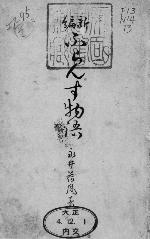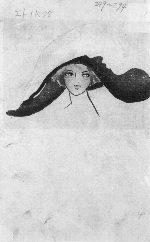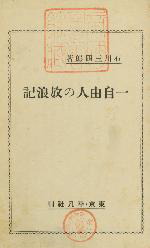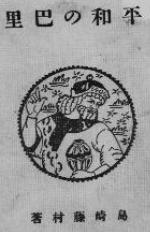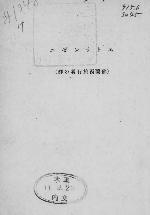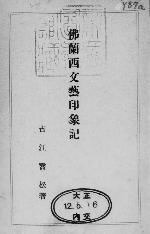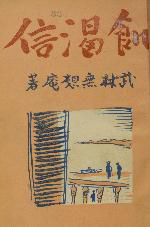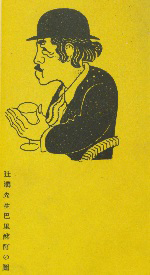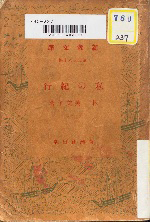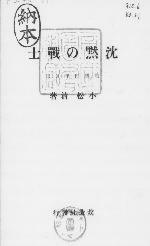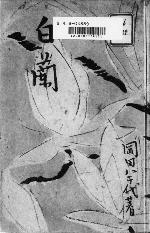![]()
Chapter 1: Literature
Section 1: France as viewed by the literati
The feelings for France phrased by HAGIWARA Sakutaro (1886-1942) as, "I wish I could go to France but/ France is far away/ So instead I will put on a new coat/ and set out on an unplanned journey" (Ryojō) show the fascination which people of culture had for France. A large number of writers, artists and journalists visited France especially after World War I as a result of being influenced by NAGAI Kafu (1879-1959) who visited France in 1907, and SHIMAZAKI Toson (1872-1943) who visited in May 1913. Although first filled with fascination and adoration for France, before long they were faced with the more profound, true essence of France, and they were then left swaying between acceptance and rejection when faced with the deviation between their infatuation and reality. The flow of the acceptance of French culture from Kafu and Toson to YOKOMITSU Riichi (1898-1947) and others would end up with finally being free from the conflict with their fascination by the work Nemure Pari [KH248-72] by KANEKO Mitsuharu (1895-1975), in which he describes the reality of Paris with a cold gaze in an extreme lifestyle focused on survival.
Individuals who visited France during the Meiji Era
ARISHIMA Ikuma, Nan’ō no hi, Shinchōsha, 1916 [F13-A76ウ] 
Western-style painter and novelist ARISHIMA Ikuma (1882-1974) visited Europe in June 1905 and studied painting and sculpting in mainly Italy and France. Together with his older brother Takeo (1878-1923), who later joined him in Europe, he toured the various countries of Europe before staying in Paris and then returning to Japan in February 1910. After returning to Japan, he was active in the literary world as well, introducing the painter Paul Cézanne (1839-1906) and establishing the Nika Association. This text is a collection of short stories set against the scenery of southern Europe, and Tenpurufujin (lit. Madame Temple), the only one set in France, in which the main character is a Japanese painter staying in Paris, is the story of his relationship with a mysterious noblewoman he meets at an exhibition.
NAGAI Kafū, Shinpen Furansu monogatari, Hakubunkan, 1915 [F13-N14-13ウ] 
After a four-year stay in the United States, NAGAI Kafu travelled to France as an employee of the Lyon branch of the Yokohama Specie Bank, and he worked in Lyon for 8 months and then stayed in Paris for 2 months after resigning his job, before returning to Japan in July of the following year. Despite the shortness of his stay, his experience in France had a major influence on Kafu and his works became the starting point for the fascination with France in Japanese literature.
This text was published by request of the publisher against Kafu's will reorganizing the contents after the first edition of Furansu Monogatari (lit. French Stories), a collection of works that he contributed to various magazines and newly wrote after his return to Japan, was banned. The 3 works Fune to kuruma (lit. Ship and car), Rōngawa no hotori (lit. On the Rhone), and Aki no chimata (lit. Streets of Autumn), which were originally at the end of Amerika monogatari (lit. American Stories), [17-330] were included at the beginning in editions after 1918, with the contents reorganized on the whole. The original composition, however, can be read in the 5th volume of Iwanami Shoten's Kafū zenshū (lit. Complete works of Kafu Nagai) [KH385-E6].
YOSANO Hiroshi and YOSANO Akiko, Pari yori, Kaneobun’endō, 1914 [349-294] 
In May 1912, YOSANO Akiko (1878-1942) went to Europe on the Trans-Siberian Railway after her husband Hiroshi (Tekkan 1873-1935) who had travelled to France the year before. This text is a magnificent book which includes a large number of photos and is a collection of accounts of the trip by both husband and wife, describing their experiences seeing the France of Belle Epoque. Compared to Hiroshi, who maintains a viewpoint of comparing everything to Japan and providing indifferent descriptions of facts, Akiko devoted herself to people watching. The women of Paris in particular left a strong impression on Akiko, with their lifestyle of following trends and fashions while still not forgetting their own individual expressiveness (Pari no ryosō yori (lit. From the inn in Paris)). The work also notes an unforgettable moment for the two, when they met the sculptor François Auguste René Rodin (1840-1917), who was 72 years old at the time (Rodan'ō (lit. Mr. Rodin)). Akiko, who grew increasingly concerned with the couple's children who remained in Tokyo while they enjoyed their time in Paris, returned to Japan in October of the same year, and Hiroshi returned in January of the following year. The illustrations were provided by the artist TOKUNAGA Ryushu (1871-1936), with whom the couple was on friendly terms.
Individuals who visited France during the Taisho Era
ISHIKAWA Sanshirō, Ichi jiyūjin no hōrōki, Heibonsha, 1929 [595-77] 
Anarchist author ISHIKAWA Sanshiro (1876-1956) travelled to France aboard a French ship in March 1913, fleeing from government oppression after the High Treason Incident of 1910, and lived his life wandering from country to country in Europe. He stayed longest in France before returning to Japan in October 1920. This text was mostly written during his stay in Europe, and is a collection of essays that were published in various newspapers and magazines including observations from his keen insight into Western civilization and discussion about Japan based on these insights. The compositions regarding his experiences during World War I which began while he was in Europe, are interesting records which convey the conditions of the time.
SHIMAZAKI Tōson, Heiwa no Pari, Sakurashobō, 1915 [71-483] 
This is a work collecting Paris news sent to the Tōkyō Asahi Shinbun newspaper from August 1913 to May of the following year by SHIMAZAKI Toson, who visited France in May 1913 and settled in Paris, which describes events until he evacuated to the provincial city of Limoges as a result of the outbreak of World War I. This journey to France was also a means of escape from the heavy burden of the incident later described in Shinsei [377-133] (the love affair with his niece Komako). At first, he mostly wrote about superficial impressions and events. However, a change can be seen that he begins to delve into the deeper aspects of France, such as the relationship between tradition and creativity in civilization when he understands Paris in which "a grand architecture and design move together as a whole" (Futatabi Pari no ryosō nite (lit. At the inn in Paris, again) 4). He also mentions the characteristics of the Japanese people such as being skillful at making fine crafts and the flexibility on imitation of other cultures, and also explains the need to be able to correctly judge and assess oneself as a Japanese (Ongakukai no yo, sonota (lit. Evening of the concert, etc.) 2).
SHIMAZAKI Tōson, Etoranzē, Shun’yōdō, 1922 [915.6-SH45ウ] 
In November 1914, Toson returned from his place of refuge in Limoges to Paris, and then returned to Japan aboard the Atsuta-maru in July 1916. This text is a compilation of compositions which were published in the Tōkyō Asahi Shinbun newspaper under the same title from September 1920 to January of the following year and then retitled as Furansu kikō (lit. French journey) thereafter, and were serialized in issues of Shinshōsetsu [雑8-30] from April 1921 to April of the following year. This is a record of his stay in Paris which he began to make 4 years after his return in a state of mind of "still half being on a journey" and, in this work, he also described relationships with japanese people who he had met while on his journey. The descriptions of Paris preparing for the war, his life in the natural environment of Limoges, and other things that influenced him are also interesting.
YOSHIE Takamatsu, Furansu bungei inshōki, Shinchōsha, 1923 [950.4-Y87aウ] 
Poet and French literature scholar YOSHIE Takamatsu (1880-1940) travelled to Paris during World War I and studied at Paris-Sorbonne University. After his return to Japan in 1920, he established the Department of French Literature at Waseda University, and while cultivating the next generation of poets and French literature scholars, such as SAIJO Yaso (1892-1970), he also left behind contributions in introductions to and translation of French literature. This text provides observations on authors including Paul Claudel (1868-1955) and Anatole France (1844-1924), and also on trends in popular theater and new historical plays. The descriptions of the relationships between nature, scenery and humans, interlaced with famous quotes from French literature, are also very impressive.
TAKEBAYASHI Musōan, Kikatsushin, Shinjidaisha, 1930 [595-236] 
In 1920, after getting married, TAKEBAYASHI Musoan (1880-1962) visited France with his wife Fumiko (1888-1966) and they returned to Japan in 1922 after the birth of their eldest daughter Yvonne (Ioko, 1920-1965). Although they visited France again the next year, they had difficulties and Fumiko supported their living by running a restaurant and performing japanese traditional dances. Musoan continued to be supported by Fumiko, even after Fumiko, who was always possessed of a more wild character, began living together with a Japanese businessman, before returning to Japan in 1934. This text is a collection of reports on his life in Paris contributed to Japanese magazines during his stay, and the work is written in a very liberal style, also including I-novels, essays and confessions on his personal love life and interpersonal relationships.
Individuals who visited France during the early Showa Era
TSUJI Jun, Zetsubō no sho, Banrikakushobō, 1930 [603-222] 
In January 1928, critic TSUJI Jun (1884-1944), under the title of 1st literary correspondent to Paris for the Yomiuri Shimbun newspaper, travelled to France with his eldest son Makoto (1913-1975), born to TSUJI and feminist ITO Noe (1895-1923), and returned to Japan in January of the following year via Siberia. The Pari no geta (lit. Clogs in Paris) in this text is a collection of communications sent to the Yomiuri Shimbun. TSUJI, who claimed to be a Dadaist, lived the life of a vagabond while publishing his criticism of civilization from his own unique viewpoint. This text shows how he devoured the novel Daibosatsutōge which he took with him without being interested in sightseeing, and conveys his fear that the incorporation of Western civilization had destroyed Japan's own unique culture, presenting how TSUJI developed a new awareness of himself in the alien civilization as the West.
OKAMOTO Kanoko, Sekai ni tsumu hana, Jitsugyōnonihonsha, 1936 [700-71] 
OKAMOTO Kanoko (1889-1939) visited France near the end of 1929 in a party of 5 including her husband Ippei (1886-1948), a popular cartoonist, her son Taro (1911-1996), and youths who lived with them. The family was so financially well off thanks to Ippei's royalties on his works that they owned houses on both banks of the Seine and Kanoko also enjoyed a free and open lifestyle, visiting operas and famous restaurants, enjoying private exhibitions by the painters of the time, and other activities. When the couple returned to Japan in 1932, Taro remained in Paris and studied philosophy and ethnology at Paris-Sorbonne University, while also coming into contact with abstractionism and surrealism and associating with a number of artists. This work is a collection of narrative travel accounts by Kanoko, who became a novelist after returning to Japan, and all of the title lettering and illustrations are also by Kanoko herself. The illustration on the title page of Furansu hen (lit. France Part) is of a man and a woman who had come to Longchamp Racecourse.
HAYASHI Fumiko, Watakushi no kikō, Shinchōsha, 1939 [780-237] 
HAYASHI Fumiko (1903-1951) travelled to France via the Trans-Siberian Railway in November 1931. For Fumiko, who became popular for her autobiographical novel Hōrō ki [596-254], this was a journey to find new ground as a novelist. This work depicts the conditions of her solo journey, taking third class trains, and also records in detail her expenses for the trip until reaching Paris (Pari made seiten (lit. Sunny to Paris)). This book describes that she went to cafes and bakeries in more common areas, and visited art galleries, movie theaters and occasionally amusement districts in spite of being in difficulties caused by the sudden fall of yen under the Great Depression in Paris, showing how Fumiko fully enjoyed the Paris atmosphere and improved her own sensibilities. After a stay of approximately half a year, Fumiko returned to Japan in June 1932, the following year, and devoted herself to the life of a novelist.
YOKOMITSU Riichi, Ōshū kikō, Sōgensha, 1937 [729-121] 
In February 1936, YOKOMITSU Riichi left for a trip to Europe to report on the Berlin Olympics as a special correspondent for the Tōkyō Nichinichi Shinbun newspaper and other media. This text is a work compiled after he returned to Japan in August of the same year, based on his journals and letters written during his trip. YOKOMITSU, who had travelled to Europe not of his own will, but due to prompting by those around him, uses a number of emotional expressions to record his impression immediately after arriving, such as "the melancholy of Paris" and "my body feels as though it has been ground to powder". However, before long he switches to a more objective viewpoint, and depicts Paris' conditions as it is caught up in the vortex of political confusion with the rise of fascism. He also visited exhibitions by Henri Matisse (1869-1954) and Paul Cézanne (1839-1906) and one can see his interest in art as he compared the changes in Cézanne's art to literature. Together with his major work of his later years Ryoshū (lit. the melancholy felt on a journey), this text also describes his conflicts resulting from placing himself in an absolutely differet culture.
KOMATSU Kiyoshi, Chinmoku no senshi, Kaizōsha, 1940 [915.6-Ko61ウ] 
KOMATSU Kiyoshi (1900-1962) first visited France in 1921 and, after returning to Japan in 1931, introduced to Japan trends in the French literature of André Malraux (1901-1976), who had been his friend during his stay in France, and others. In 1937, KOMATSU again went to France together with his wife as a special correspondent for the Hōchi Shinbun newspaper, remained in Paris after resigning his job, contributed to magazines and participated in the editing of the French-Japanese cultural exchange magazine France-Japon [Z51-B510]. This text is a record from the end of August 1939, just before the outbreak of World War II, the advance of Germany and the couple's escape from Paris in June 1940, just before the surrender, heading for Lisbon, where the repatriation ship Haruna-maru waited. He provides descriptions, shaped by his love and sorrow for France, of the people's uncertainty around the outbreak of the war, the relaxed tension due to the distance of the battlefields, and the increasing anxiety accompanying the advance of the German army, and it is also a very valuable work from a documentary literature viewpoint.
OKADA Yachiyo, Byakuran, Daigensha, 1943 [914.6-O388ウ] 
OKADA Yachiyo (1883-1962) was the sister of producer and playwright OSANAI Kaoru (1881-1928), and the cousin of western-style painter FUJITA Tsuguharu (1886-1968) who was famous in France. Yachiyo, known as an author and dramatic critic, travelled to France in 1930, together with her husband, painter OKADA Saburosuke (1869-1939). As a result of worsened relationship between husband and wife, she remained in Paris after her husband returned to Japan and finally returned to Japan in October 1934. In this text, which collects a large number of the essays she wrote during her stay in Paris, she depicted vividly with a variety of rich, colorful expressions the topics of particular interest to women, such as the view from the town, sweets and flowers of the seasons.


